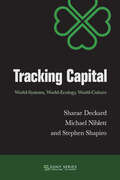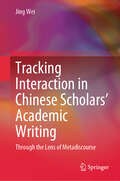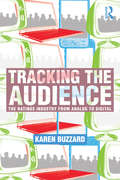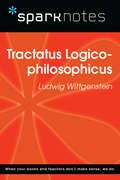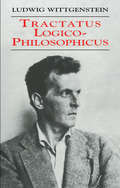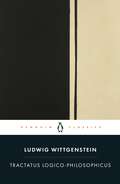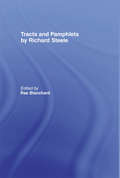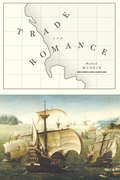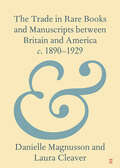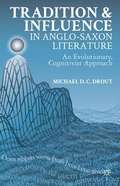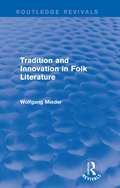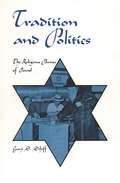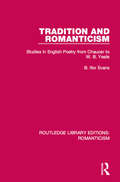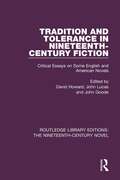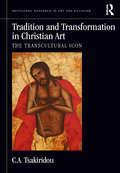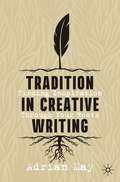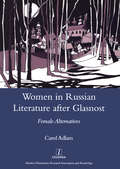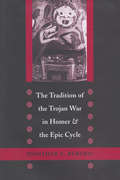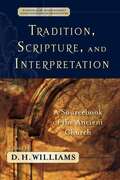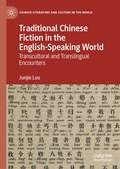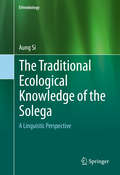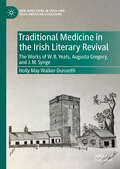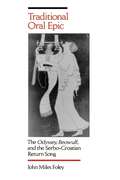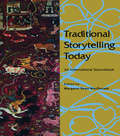- Table View
- List View
Tracking Capital: World-Systems, World-Ecology, World-Culture (SUNY series, Literature . . . in Theory)
by Sharae Deckard Michael Niblett Stephen ShapiroTracking Capital introduces new ways to understand the entanglement of cultural forms and practices in economic, social, and ecological crises and struggles. Building on the fundamental insights of world-systems analysis, the book offers readers a series of rubrics, keywords, and concepts—such as zemiperiphery, registration, and commodity chains—to enable more integrated, transdisciplinary methods of literary and cultural study. Throughout, Sharae Deckard, Michael Niblett, and Stephen Shapiro foreground the role of culture in both consolidating and contesting the classism, racism, sexism, and ecocide constitutive of the modern world-system. In the context of capitalism's ongoing bloody war against the poor, the powerless, and the planet, Tracking Capital provides tools with which to diagnose the morbid symptoms of the present, as well as to plot possible steps on the road to a better future.
Tracking Interaction in Chinese Scholars’ Academic Writing: Through the Lens of Metadiscourse
by Jing WeiThis book tracks changes in the use of metadiscourse in Chinese scholars’ English and Chinese research articles, discusses how these changes reflect changes in Chinese scholars’ interactions with their peers in China and outside China, and analyzes how Chinese scholars are responding to changes in the academic context that embrace and shape rhetorical practices in the academic world. Around the turn of the twenty-first century, the Chinese government declared the goal of “enhancing international soft power,” and one important way to achieve this goal is to promote China’s global academic influence. China has indeed made remarkable strides in terms of academic output by publishing Chinese scholars’ research papers and monographs around the world. However, “international soft power” means more than just the export of papers or books; it means connecting to and participating in the academic world. For this to happen, Chinese scholars must get to know their international counterparts, understand their rhetorical preferences, and be willing (and able) to accommodate their needs.
Tracking the Audience: The Ratings Industry From Analog to Digital
by Karen BuzzardIn Tracking the Audience: The Ratings Industry From Analog to Digital, author Karen Buzzard examines the key economic, political, and competitive factors that have influenced ratings methods dominant in each of the markets for radio, TV, and the Internet, tracing the practice¹s history from its early beginnings up to its most recent advances. Beginning with the birth of the industry in 1929, Tracking the Audience traces the establishment of a standardized ratings "currency" as it evolved to meet the needs of the analog broadcast system, and explores the search for new gold standards necessitated by the devastating effects of the digital revolution. Buzzard examines key challenges to the established system by discussing the movement from traditional sampling methods to new, more transparent measurements. More than a history of the ratings industry itself, it also tracks the evolving business model for the broadcast industry. Tracking the Audience: The Ratings Industry From Analog to Digital shows how the development of conceptual tools designed to measure and package radio, TV, and Internet audiences is the result of a variety of historical factors. With a detailed examination of ratings providers, their methods, and their attempts to adjust to meet new demands a digital age, this volume explains how a standardized broadcast system of audience measurement ratings has evolved, and where it is going in the future.
Tractatus Logico-philosophicus (SparkNotes Philosophy Guide)
by SparkNotesTractatus Logico-philosophicus (SparkNotes Philosophy Guide) Making the reading experience fun! SparkNotes Philosophy Guides are one-stop guides to the great works of philosophy–masterpieces that stand at the foundations of Western thought. Inside each Philosophy Guide you&’ll find insightful overviews of great philosophical works of the Western world.
Tractatus Logico-Philosophicus (Barnes And Noble Library Of Essential Reading #Vol. 4447)
by Ludwig Wittgenstein"Philosophy is not a theory," asserted Austro-British philosopher Ludwig Wittgenstein (1889–1951), "but an activity." In this 1921 opus, his only philosophical work published during his lifetime, Wittgenstein defined the object of philosophy as the logical clarification of thoughts and proposed the solution to most philosophic problems by means of a critical method of linguistic analysis. In proclaiming philosophy as a matter of logic rather than of metaphysics, Wittgenstein created a sensation among intellectual circles that influenced the development of logical positivism and changed the direction of 20th-century thought.Beginning with the principles of symbolism and the necessary relations between words and objects, the author applies his theories to various branches of traditional philosophy, illustrating how mistakes arise from inappropriate use of symbolism and misuses of language. After examining the logical structure of propositions and the nature of logical inference, he discusses the theory of knowledge as well as principles of physics and ethics and aspects of the mystical.Supervised by the author himself, this translation from the German by C. K. Ogden is regarded as the definitive text. A magisterial introduction by the distinguished philosopher Bertrand Russell hails Wittgenstein's achievement as extraordinarily important, "one which no serious philosopher can afford to neglect." Introduction by Bertrand Russell.
Tractatus Logico-Philosophicus: The New Translation (Routledge Classics Ser.)
by Ludwig WittgensteinWidely regarded as one of the most influential philosophical works of the twentieth century, Ludwig Wittgenstein's Tractatus Logico-Philosophicus is a succinct yet wide-ranging exploration of language and logic, science and mysticism, which has inspired generations of thinkers, artists and poets. In a series of short, bold statements, Wittgenstein seeks to define the limits of language, its relation to logic, its power and its inherent failings. Originally published in the early 1920s, it is the only book-length work the renowned philosopher published in his lifetime.In this thrilling new translation, Alexander Booth displays an extraordinary sensitivity to the subtle influence on Wittgenstein's gem-like prose - at once specialist and, often, remarkably plain-spoken - of his background in mechanical engineering, while highlighting the underlying poetry of this seminal text.
Tracts and Pamphlets by Richard Steele
by Rae BlanchardFirst Published in 1968. Sir Richard Steele's plays and major periodicals have been reprinted in modern times. But the miscellaneous tracts and pamphlets, which in his own day in the eighteenth century, ran into many editions and made his name famous, must now be sought out in antiquarian book shops and, one here, one there, in university libraries. To bring them all together for rereading is the purpose of this collected edition.
Trade and Romance
by Michael MurrinIn Trade and Romance, Michael Murrin examines the complex relations between the expansion of trade in Asia and the production of heroic romance in Europe from the second half of the thirteenth century through the late seventeenth century. He shows how these tales of romance, ostensibly meant for the aristocracy, were important to the growing mercantile class as a way to gauge their own experiences in traveling to and trading in these exotic locales. Murrin also looks at the role that growing knowledge of geography played in the writing of the creative literature of the period, tracking how accurate, or inaccurate, these writers were in depicting far-flung destinations, from Iran and the Caspian Sea all the way to the Pacific. With reference to an impressive range of major works in several languages—including the works of Marco Polo, Geoffrey Chaucer, Matteo Maria Boiardo, Luís de Camões, Fernão Mendes Pinto, Edmund Spenser, John Milton, and more—Murrin tracks numerous accounts by traders and merchants through the literature, first on the Silk Road, beginning in the mid-thirteenth century; then on the water route to India, Japan, and China via the Cape of Good Hope; and, finally, the overland route through Siberia to Beijing. All of these routes, originally used to exchange commodities, quickly became paths to knowledge as well, enabling information to pass, if sometimes vaguely and intermittently, between Europe and the Far East. These new tales of distant shores fired the imagination of Europe and made their way, with surprising accuracy, as Murrin shows, into the poetry of the period.
The Trade in Rare Books and Manuscripts between Britain and America c. 1890–1929 (Elements in Publishing and Book Culture)
by Danielle Magnusson Laura CleaverThis Element examines the trade in rare books and manuscripts between Britain and America during a period known as the 'Golden Age' of collecting. Through analysis of contemporary press reports, personal correspondence, trade publications and sales records, this study contrasts American and British perspectives as rare books passed through the commercial market. The aim is to compare the rhetoric and reality of the book trade in order to assess its impact on emerging cultural institutions, contemporary scholarship and shifting notions of national identity. By analysing how markets emerged, dealers functioned and buyers navigated the market, this Element interrogates accepted narratives about the ways in which major rare book and manuscript collections were formed and how they were valued by contemporaries.
Tradition and Influence in Anglo-Saxon Literature: An Evolutionary, Cognitivist Approach
by Michael D. C. DroutThis book introduces lexomics, the use of computer-aided statistical analysis of vocabulary, to measure influence and integrate research from cognitive psychology and evolutionary biology with traditional, philological approaches to literature. Connecting the theory of tradition with the phenomenon of influence, Drout moves beyond current theories.
Tradition and Innovation in Folk Literature (Routledge Revivals)
by Wolfgang MiederIn this book, first published in 1987, Wolfgang Mieder follows the intriguing trail of some of the best known pieces of folk literature, tracing them from their roots to modern uses in advertising, journalism, politics, cartoons, and poetry. He reveals both the remarkable adaptability of these tales and how each variation reflects cultural and historical changes. Fairy tales, legends, folk songs, riddles, nursery rhymes, and proverbs are passed from generation to generation, changing both in form and meaning with each use. This book will be of interest to students of literature.
Tradition and Romanticism: Studies in English Poetry from Chaucer to W. B. Yeats (Routledge Library Editions: Romanticism #8)
by B. Ifor EvansFirst published in 1940. This title examines the tradition of Romantic literature, and the conception of poetry held by poets and critics throughout the centuries. Evans explores the writings of Chaucer, Shakespeare, Wordsworth and Coleridge, up until the modernist movement and the works of W. B. Yeats and T. S. Eliot. This title will be of interest to students of literature.
Tradition and Tolerance in Nineteenth Century Fiction: Critical Essays on Some English and American Novels (Routledge Library Editions: The Nineteenth-Century Novel #20)
by David Howard, John Lucas and John GoodeFirst published in 1966, this book collects six essays which discuss the experience of social change as it reveals itself in the work of several nineteenth century novelists. In the novels studied, and the discussion of fiction that follows, the authors argue that all these novelists’ attempts to confront social change — to connect old with new, past with present and the attempted inclusiveness of vision in a changing society — sooner or later fail. The essays are polemic in arguing against the contemporary critical consensus that this failure is a limitation of imaginative intelligence rather than an endorsement of a receding past which the process of change was charged with destroying.
Tradition and Transformation in Christian Art: The Transcultural Icon (Routledge Research in Art and Religion)
by C.A. TsakiridouTradition and Transformation in Christian Art approaches tradition and transculturality in religious art from an Orthodox perspective that defines tradition as a dynamic field of exchanges and synergies between iconographic types and their variants. Relying on a new ontology of iconographic types, it explores one of the most significant ascetical and eschatological Christian images, the King of Glory (Man of Sorrows). This icon of the dead-living Christ originated in Byzantium, migrated west, and was promoted in the New World by Franciscan and Dominican missions. Themes include tensions between Byzantine and Latin spiritualities of penance and salvation, the participation of the body and gender in deification, and the theological plasticity of the Christian imaginary. Primitivist tendencies in Christian eschatology and modernism place avant-garde interest in New Mexican santos and Greek icons in tradition.
Tradition in Creative Writing: Finding Inspiration Through Your Roots
by Adrian MayTradition in Creative Writing: Finding Inspiration Through Your Roots encourages writers to rediscover sources of creativity in the everyday, showing students how to see your writing as connected to your life. Adrian May addresses a key question for many beginning writers: Where do you get your ideas from? May argues that tradition does not mean anti-progress—but is instead a kind of hidden wealth that stems from literary and historical traditions, folk and songs, self and nature, and community. By drawing on these personal and traditional wellsprings of inspiration, writers will learn to see their writing as part of a greater continuum of influences and view their work as having innate value as part of that cultural and artistic ecology. Each chapter includes accessible discussion, literary and critical readings, creative examples, and writing exercises. While the creative examples are drawn from song lyrics and poetry, the writing exercises are appropriate for all genres. Undergraduates and practitioners will benefit from this guide to finding originality in writing through exploring sources of creative inspiration.
A Tradition of Infringement: Women in Russian Literature After Glasnost
by Carol Adlam"The Russian literary world was shaken by the wide-reaching reforms of the late Soviet period (1985-91) and the Soviet Union's subsequent collapse. During this time the phenomenon of 'alternative' literature emerged, characterized by an emphasis on thematic, structural, and linguistic transgression of both Soviet-era values and the enduring Russian tradition of civic engagement and moral edification through literature. Through close textual analysis, Adlam examines the relationship of this literary phenomenon to issues of gender and creative authority, providing detailed discussion of several of the most significant women writers of the period, among them Valeriia Narbikova, Liudmila Petrushevskaia and Nina Sadur."
The Tradition of the Trojan War in Homer and the Epic Cycle
by Jonathan S. BurgessAlthough the Iliad and Odyssey narrate only relatively small portions of the Trojan War and its aftermath, for centuries these works have overshadowed other, more comprehensive narratives of the conflict, particularly the poems known as the Epic Cycle. In The Tradition of the Trojan War in Homer and the Epic Cycle, Jonathan Burgess challenges Homer's authority on the war's history and the legends surrounding it, placing the Iliad and Odyssey in the larger, often overlooked context of the entire body of Greek epic poetry of the Archaic Age. He traces the development and transmission of the Cyclic poems in ancient Greek culture, comparing them to later Homeric poems and finding that they were far more influential than has previously been thought.
Tradition, Scripture, and Interpretation: A Sourcebook of the Ancient Church (Evangelical Ressourcement)
by D. H. WilliamsTradition, Scripture, and Interpretation supplements a valuable series that helps modern church leaders return to the wisdom and insight of the early church fathers in order to apply their ancient understandings of Christian belief and practice to ministry in the twenty-first century. This sourcebook gathers key writings from the first through sixth centuries on various topics of concern to the church yesterday and today. The writings are arranged thematically, and within each theme, chronologically, revealing how the Christian tradition on a given topic developed over time. The anthology begins with a chapter examining the close relationship between Scripture and tradition in the minds of early church leaders.
Traditional and Analytical philosophy
by Tugendhat, Ernst and Gorner, P. A. Ernst Tugendhat P. A. GornerA major study of some of the central and abiding questions of metaphysics and the philosophy of language by one of the most eminent contemporary German philosophers. Originally published in 1976, it was first translated into English in 1982. Ernst Tugendhat was trained in the Heideggerian modes of phenomenological and hermeneutical thinking. Yet increasingly he came to believe that the most appropriate approach was from within the framework of analytical philosophy. This book grew out of that conviction, and as such it brought a fresh perspective to some of the rarely examined assumptions and methods of analysis. Professor Tugendhat begins by showing how semantic analysis related to such 'traditional' conceptions of philosophy as Aristotle's and Kant's, and the manner in which it treats such 'traditional' problems as being and consciousness. From these considerations he develops a systematic, thorough and original theory of reference, predication and individuation, which make it an invaluable resource for anyone with an interest in the philosophy of language.
Traditional Chinese Fiction in the English-Speaking World: Transcultural and Translingual Encounters (Chinese Literature and Culture in the World)
by Junjie LuoThis book develops interdisciplinary and comparative approaches to analyzing the cross-cultural travels of traditional Chinese fiction. It ties this genre to issues such as translation, world literature, digital humanities, book culture, and images of China. Each chapter offers a case study of the historical and cultural conditions under which traditional Chinese fiction has traveled to the English-speaking world, proposing a critical lens that can be used to explain these cross-cultural encounters. The book seeks to identify connections between traditional Chinese fiction and other cultures that create new meanings and add to the significance of reading, teaching, and studying these classical novels and stories in the English-speaking world. Scholars, students, and general readers who are interested in traditional Chinese fiction, translation studies, and comparative and world literature will find this book useful.
The Traditional Ecological Knowledge of the Solega
by Aung SiThis book covers the ethnobiology and traditional ecological knowledge (TEK) of the Solega people of southern India. Solega TEK is shown to be a complex, inter-related network of detailed observations of natural phenomena, well-reasoned and often highly accurate theorizing, as well as a belief system, derived from cultural norms, regarding the relationships between humans and other species on the one hand, and between non-human species on the other. As language-based studies are strongly biased toward investigations of ethno-taxonomy and nomenclature, the importance of studying TEK in its proper context is discussed as making context and encyclopedic knowledge the objects of study are essential for a proper understanding of TEK.
Traditional Medicine in the Irish Literary Revival: The Works of W.B. Yeats, Augusta Gregory, and J. M. Synge (New Directions in Irish and Irish American Literature)
by Holly May Walker-DunseithThis book explores representations of traditional medicine and healing practices in Irish Revival-era literature spanning from the late nineteenth century to the early twentieth century. Specifically, the book focuses on the work of William Butler Yeats, Lady Augusta Gregory, and John Millington Synge. The author examines folk medical practices and analyses how folk medicine appears in literature, bringing to light fresh contexts and materials including diaries, letters, folklore collections, and medical texts. By writing the first book to explore the place of traditional medicine in Irish literature, Walker-Dunseith sheds light on a distinctive area of Irish life and practice that gestures towards the possibility of a culture and nation in the act of healing itself and questioning nationalistic discourses.
Traditional Oral Epic: The Odyssey, Beowulf, and the Serbo-Croation Return Song
by John Miles FoleyJohn Miles Foley offers an innovative and straightforward approach to the structural analysis of oral and oral-derived traditional texts. Professor Foley argues that to give the vast and complex body of oral "literature" its due, we must first come to terms with the endemic heterogeneity of traditional oral epics, with their individual histories, genres, and documents, as well as both the synchronic and diachronic aspects of their poetics.Until now, the emphasis in studies of oral traditional works has been placed on addressing the correspondences among traditions—shared structures of "formula," "theme," and "story-pattern." Traditional Oral Epic explores the incongruencies among traditions and focuses on the qualities specific to certain oral and oral-derived works. It is certain to inspire further research in this field.
Traditional Storytelling Today: An International Sourcebook
by Margaret Read MacDonaldFirst Published in 1999. Routledge is an imprint of Taylor & Francis, an informa company.
